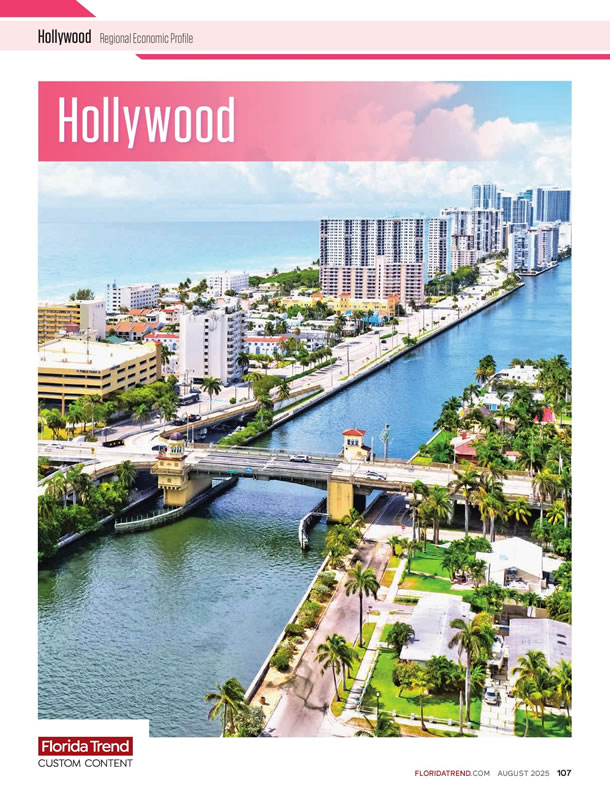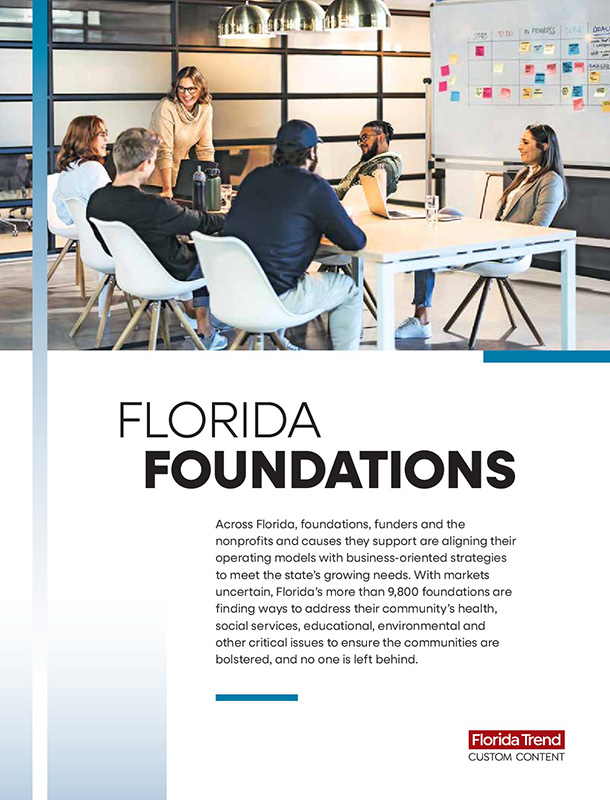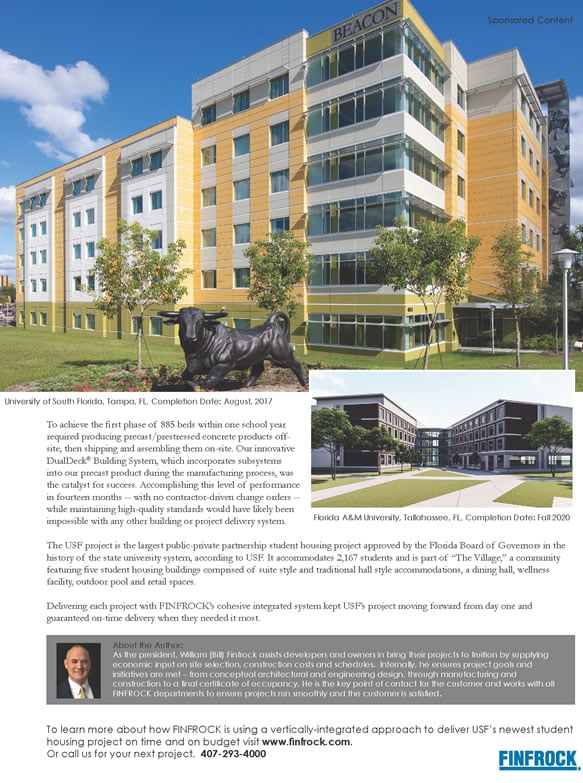May 2025 | Brittney J. Miller
Private islands are the fodder of American dreams, as well as status indicators that drive the rich and the wealthy to claim their own piece of paradise. Often, they find their pick in Florida, where the private island market is as active — and as exclusive — as it gets, says Jenna Stauffer, a real estate broker for Sotheby’s International Realty. The luxury real estate brand has 1,100 offices across 84 countries and territories, including dozens serving Florida.Florida’s total number of private island sales is tough to track because many happen off-market. But Stauffer says the state’s island market is booming alongside its population.
The influx of residents — many coming from money, with fintech company SmartAsset ranking the state No.1 for the highest net migration of wealthy young Americans in a 2024 study — has driven up demand for high-end real estate. And as inventory for waterfront homes gets tighter, some buyers are turning to private islands as the ultimate retreat.
“There’s always demand from high-net-worth and ultra-high-net-worth buyers looking for privacy, luxury and their own slice of paradise,” Stauffer says. “Owning a private island isn’t just about real estate — it’s the ultimate status symbol.”
The naturally limited supply also drives demand. Florida is estimated to have more than 4,000 islands of 10-plus acres — the second-most of any state behind Alaska. As of press time, 25 islands were listed for sale in Florida, according to Private Islands Inc., a global marketplace for private island sales and rentals.
Stauffer, who is based in Key West, says the Florida Keys are a regional hotspot for private island sales in the state — “the most desirable for that true tropical island feel, plus deep-water access.”
The million-dollar (or, in this case, millions-of-dollars) question: How much can you buy an island for? It depends, Stauffer says.
Smaller, undeveloped islands typically start between $1 million and $5 million. (On Private Islands Inc., the cheapest island for sale at press time was a $349,000 undeveloped four-acre island south of Cedar Key in the Big Bend region.) Islands with infrastructure can range from $10 million to $50 million and beyond. Pumpkin Key, an ultra-luxury 26-acre island in the Florida Keys featuring a 20-slip marina and a helipad, is currently listed for $75 million. Islands in prime locations with easy access to the mainland are especially valuable, usually selling quickly.
Stauffer says she’s seeing more international buyers grab up Florida’s private islands. She also noted that more buyers are looking for eco-conscious features on island properties, including off-grid solar, sustainable construction and hurricane-resistant designs.
Looking ahead, she doesn’t see demand for Florida island oases slowing down anytime soon.
“Private islands are always going to be in demand because there will always be buyers looking for privacy, security and exclusivity,” she says. “Prices are likely to hold strong.”
No Florida island is the same. In fact, many diverge from the glitzy private island stereotype. In this report, Florida Trend explores the Sunshine State’s array of islands — from the Panhandle to South Florida — and spotlights a selection with distinct uses, from a new city park to an emerging cryptocurrency hub.
“Owning a private island isn’t just about real estate — it’s the ultimate status symbol.” — Jenna Stauffer, a real estate broker for Sotheby’s International Realty
BLACK’S ISLAND
Port St. Joe, Gulf County
Legend has it that Black’s Island, a seven-acre plot sheltered in St. Joseph Bay along the Florida Panhandle, inherited its name from a rumored previous owner — “Black Sam” Bellamy. The 18th century Englishman was reported to be the wealthiest pirate in recorded history, capturing 50-plus ships and plundering an estimated $120 million.
Nearly three centuries later, the private island is a far cry from its notorious past — although riches still abound in what’s now known as a luxury vacation spot. (For what it’s worth, Florida Trend couldn’t corroborate the land’s historied past.)
Owner Scott Seymour, an Atlanta developer, first heard of Black’s Island a decade ago. Its owner at the time (not a pirate) had started construction on the land in the early 2000s, intending to sell the units until the 2008 recession stalled the project. Seymour purchased the land in 2018 and, despite setbacks from Category 5 Hurricane Michael in 2018, eventually finished the project with a $10-million investment.
Black’s Island is now equipped with 26 bungalows elevated 14 feet, each unit ranging from 1,225 to 1,425 square feet. Their round shape — a signature feature of Ashville, N.C. home construction company Deltec — makes them “hurricane proof” while offering panoramic views, Seymour says. Because they’re elevated, “we had no water damage caused from the tidal surge” during Hurricane Michael, he says, and there was “no structural damage at all.”
An elevated 1,200-foot-long boardwalk weaves among the units. There’s also a four-story clubhouse, cabana, pool, sundecks and floating trampoline. Seymour listed a variety of activities available on the island, including snorkeling, fishing, beach volleyball and kayaking. Visitors can enjoy spa, food, bar and concierge services. They can also travel 3 miles to the bayfront Port St. Joe, where a walkable downtown features restaurants, boutiques and shoreline.
Vacationers can rent a bungalow starting at $850 a night. The island is a popular pick for private events like weddings, banquets, family reunions and political events.
Seymour is also selling individual bungalows for $1.5 million a pop. As of press time, he had already sold three units. His vision is for 26 owners to share the responsibility of operating the island.
“Rather than the large impact of one person owning an entire island and having to handle that expense,” Seymour says, “this way you get 26 owners with an HOA that share the expense of operating the island.”
EVER AFTER ESTATE
Unincorporated Lake County
Play, play, play.
That’s the motto Andrew Greenstein, who describes himself as a “big kid,” subscribes to. It also inspired his Ever After Estate, a home-turned-rental property on a 62-acre island among the marshlands of Central Florida.
Greenstein, who hails from New York City, retired at age 28 after working 125 hours a week writing papers and resumes for college students. His goal? Move to Florida, which he frequented for its theme parks and warm weather, to raise children in a big home.
He did just that, transforming an “ordinary” property in unincorporated Lake County between Clermont and Groveland into a fun-filled estate with 13 bedrooms, 9.5 bathrooms and 3.5 kitchens between a main house and two guest houses.
Every corner of his creation stems from his wildest imaginations. From his master bathroom, he can slide down a two-story waterslide into a waterfall-fed pool. Beyond lies a 14-hole mini golf course and an outdoor movie theater, which complements an indoor theater. Elsewhere on the property, another slide plunges riders into a superhero-themed ball pit filled with 23,000 colorful balls.
“There’s everything here, from quiet and peaceful nature to having a party to being a big kid,” Greenstein says. “There’s very few reasons to leave home except to go to those theme parks.”
His two kids, who are now in college, were raised at Ever After Estate. Greenstein, now 52, still lives there. For at least 60 nights a year, others can too.
Around 2009, before Airbnb rose in popularity, Greenstein started putting the giant home up for rent while he was traveling. He created a website to promote the listing. Before long, there was a waiting list of hopeful visitors — and even a waiting list to get on that waiting list, he joked. Every available night was soon booked.
“It became really popular, and that led me to make more and more homes,” Greenstein said. His company, Orlando Area Luxury Rentals, now owns four properties with similarly immersive themes ranging from board games to sweet treats. “It became a whole business that I never expected it to be.”
Ever After Estate and its two guest houses — which altogether sleep up to 43 people — attract all sorts of guests, from family reunions to business retreats to swinger groups. On average, the rental is priced at $3,000 a night plus tax and cleaning fees, making it one of Florida’s most expensive Airbnb vacation homes. Greenstein estimates he grosses around $300,000 per year on the attraction.
Influencer visits and viral social media videos continue to keep his properties fully stocked. Altogether, Orlando Area Luxury Rentals made around $3 million on its rental portfolio in 2021, its best year. Greenstein’s imagination may not stop there.
“I have some concepts for some other new houses that are things that have never been done in the world,” he says. “My M.O. is to live and play carefree. ... But these ideas are so awesome, and they sound so fun, they’re nagging me. I really want to see them come to fruition.”
BEER CAN ISLAND
Tampa Bay, Hillsborough County
You might know Russell Loomis from his infamous floating tiki bar that once claimed the waters off St. Petersburg’s Gandy Bridge. After scuffles with local officials about the location of the 74-foot-long vessel, crafted from 250-some 55-gallon drums, Loomis and his three co-owners went in search of waterfront property to park their business.
The St. Petersburg resident and self-described day trader says he came across Pine Key — more commonly known as Beer Can Island — by accident.
The dot of land in Tampa Bay is 2 miles offshore from both Apollo Beach and MacDill Air Force Base. It has a decades-long reputation for hosting partying boaters. Long before that, Beer Can Island was a docking station for warships during World War II. Over time, dredging companies dumped sand onto the five-acre isle, making it grow up to 24 acres at its largest. It’s now nine acres of upland and around 60 acres of sandbar.
The island piqued Loomis’ interest. Six months later, he had tracked down its owner and offered him $63,650 per a county appraisal. “He said, ‘Well, let me think about it and I’ll call you back,’” Loomis recounts. “I never thought I’d hear from him again. But he calls me back at 9 a.m. the next morning and says, ‘Tell you what. We’ll do the deal.’”
The transaction closed in 2017, and the four co-owners moved the 2,300-sq.-ft. tiki bar to their new investment. They accumulated 200-plus bags of trash from the isle, including chairs, umbrellas, grills and — as the nickname suggests — beer cans. They secured catering, liquor licenses and insurance. Amid never-ending legal battles over zoning and permitting, the team invested around $2 million into island amenities, including a food truck, concert stage and waterslide.
Along the way, the co-owners conjured up several ways to raise money for island operations and expenses. They began by offering country club-like memberships starting at $9 a month that included discounts on tiki bar offerings and island events, Loomis says. For a time, they sold more than 500 owner membership units at $1,000 a pop in hopes of funding owner-only events on Beer Can Island. Several charter boats offered trips to the destination.
Repeated hurricanes — including 2024’s Hurricane Helene, which put Beer Can Island eight feet underwater and destroyed the floating tiki bar — have thwarted much forward progress for their business. The co-owners even entertained a multimillion-dollar offer for selling the island after 2023’s Hurricane Idalia. But they’re persevering regardless.
As they rebuild this year, they’re focusing on temporary structures. Loomis is also working on proposing a new zoning designation specific to the island, one he’s calling “island recreation.” Early renderings feature a marina and sections of breakwaters that protect the isle and its guests from ship wakes. Eventually, the team would like to build a clubhouse, cabanas and a tiki bar restaurant there — all elevated to protect the buildings from future storms.
Most recently, the co-owners introduced a membership program via cryptocurrency: the Beer Can Island token ($BCI). It marks the first time a private island has been tokenized in cryptocurrency, Loomis says.
Token holders — which numbered around 1,500 at press time (making the token worth $0.000007) — would have access to the same discounts as traditional members once operations open again. Loomis is working on an app for users to buy or sell the crypto, purchase food and beverage on the island, and see their membership status.
“Obviously the crypto community is pretty large, and there’s a lot of money in the crypto space,” Loomis says. “If we were to attract the right person that could come in, help invest and build this place back better than it’s ever been before, that would be fantastic.”
LEGACY ISLAND
Fort Myers, Lee County
The Caloosahatchee River snakes from central-south Florida, where it helps drain Lake Okeechobee out to the Gulf. An island sits smack-dab in the waterway’s center where it splits the Cape Coral-Fort Myers metro, just a hop, skip and a jump away from the Edison Bridge.
The isle is humanmade, forged from the U.S. Army Corps of Engineers dredging the Caloosahatchee Canal decades ago. Since Fort Myers owns the river bottom, the emerging spoil island became city property.
For years, boaters casually used the island — not even an acre in size — as a resting place or picnic spot. But more concrete plans for the land were set in motion upon approval of the $91-million Luminary Hotel in Fort Myers. Its 12 stories and 243 rooms were to be built atop a parking lot the original owners had destined for waterfront parkland.
After backlash sprouted, the city proposed a compromise in 2018: Keep the hotel there and turn a nearby river island into a park. Thus, Legacy Island Park was born.
“We call it Legacy Island just because of the legacy of the people that donated the property there,” says project manager and city stormwater resource manager Richard Thompson. The island previously has been called Clint’s Island or Rat Island.
Although Thompson doesn’t anticipate more dredging in the channel, Legacy Island is still a designated spoil island for the Army Corps. That means it can’t host any permanent structures. As a workaround, the city is installing temporary structures that could be removed if needed, including kayak launches, gazebos and a boat dock. (Thompson said the city likely wouldn’t have enough manpower to remove the structures ahead of hurricanes, though.) The project will cost around $1.6 million over its two phases of construction.
“This is our first park of this nature with the island that we own,” Nicole Setzer, a city engineer in Fort Myer’s public works department, told the Fort Myers News-Press. “We are excited for this. This will be a great feature. It’s great for our boating public that wants to get out.”
HISTORIC MONKEY ISLAND
Homosassa, Citrus County
In the 1960s, a Citrus County developer unintentionally created a tiny island in the Homosassa River when he covered hazardous rock piles with dirt. It soon turned into a Florida-grown Alcatraz for five monkeys relocated from what’s now the Ellie Schiller Homosassa Springs Wildlife Park, initially a zoo-like attraction filled with exotic animals. Monkey Island is still going strong, currently housing three spider monkeys named Ralph, Ebony and Emily. A $200,000 renovation completed in 2024 added a new elevated structure with air conditioning, heating and solar panels to the island along with perimeter poles to keep visitors out. Fans can virtually observe the monkeys on recently installed island livestreams.
TARPON ISLAND
Palm Beach, Palm Beach County
Tarpon Island, a humanmade rectangular plot just over two acres, is Palm Beach’s only private island. It features a 1930s-era home — extensively renovated and expanded to nearly 30,000 square feet — along with a tennis court, two swimming pools and boat docks. It sold for $150 million last May, marking Florida’s highest-dollar residential sale of 2024. Luxury real estate magazine Mansion Global dubbed it the country’s second-priciest home sale of the year behind a $210-million Malibu estate. “That (Tarpon Island) deal set a benchmark and really showed how strong demand is at the ultra-high end of the market,” says Jenna Stauffer, a Key West-based real estate broker for Sotheby’s International Realty
BIRD KEY
Biscayne Bay, Miami-Dade County
A four-acre private island and its 33 acres of submerged land in Biscayne Bay — one of the area’s few remaining undeveloped islands — has been a bird sanctuary for decades. It’s on Miami-Dade County’s registry of threatened environmental lands and is home to cormorants, brown pelicans, herons and other feathered friends. Bird Key was embroiled in controversy when its owner of 40 years listed it for $31.5 million last April. Environmentalists feared the land would fall to developers who could turn the habitat into a residential gold mine. “Much of the habitat has been lost from Miami Beach and along the coast of Miami- Dade,” Jose Francisco Barros, president of the Tropical Audubon Society, told NBC Miami. “This island in particular serves as a refuge, a place of rest for these birds.” As of press time, the listing was still active.













